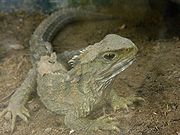
Phylogenetic diversity
Encyclopedia

Cladogram
A cladogram is a diagram used in cladistics which shows ancestral relations between organisms, to represent the evolutionary tree of life. Although traditionally such cladograms were generated largely on the basis of morphological characters, DNA and RNA sequencing data and computational...
, and the minimum spanning path is the mimimum distance between the two nodes.
This definition is distinct from earlier measures which attempted to incorporate phylogenetic diversity into conservation planning, such as the measure of 'taxic diversity' introduced by Vane-Wright, Humphries, and William.
The concept of phylogenetic diversity has been rapidly adopted in conservation planning, with programs such as the Zoological Society of London
Zoological Society of London
The Zoological Society of London is a charity devoted to the worldwide conservation of animals and their habitats...
's EDGE of Existence programme
EDGE of Existence programme
The EDGE of Existence programme is a research and conservation initiative that focuses on species deemed to be the world’s most Evolutionarily Distinct and Globally Endangered...
focused on evolutionary distinct species. Similarly, the WWF
World Wide Fund for Nature
The World Wide Fund for Nature is an international non-governmental organization working on issues regarding the conservation, research and restoration of the environment, formerly named the World Wildlife Fund, which remains its official name in Canada and the United States...
's Global 200
Global 200
The Global 200 is the list of ecoregions identified by the World Wildlife Fund as priorities for conservation. According to the WWF, an ecoregion is defined as a "relatively large unit of land or water containing a characteristic set of natural communities that share a large majority of their...
also includes unusual evolutionary phenomena in their criteria for selecting target ecoregion
Ecoregion
An ecoregion , sometimes called a bioregion, is an ecologically and geographically defined area that is smaller than an ecozone and larger than an ecosystem. Ecoregions cover relatively large areas of land or water, and contain characteristic, geographically distinct assemblages of natural...
s.
Some studies have indicated that alpha diversity
Alpha diversity
Alpha diversity is the biodiversity within a particular area, community or ecosystem, and is usually expressed as the species richness of the area. This can be measured by counting the number of taxa within the ecosystem...
is a good proxy for phylogenetic diversity, so suggesting that term has little use, but a study in the Cape Floristic Region
Cape floristic region
The Cape Floristic Region is a floristic region located near the southern tip of South Africa. It is the only floristic region of the Cape Floristic Kingdom, and includes only one floristic province, known as the Cape Floristic Province.The Cape Floristic Region, the smallest of the six recognised...
showed that using phylogenetic diversity led to selection of different conservation priorities than using species richness. It also demonstrated that PD led to greater preservation of 'feature diversity' than species richness alone.

